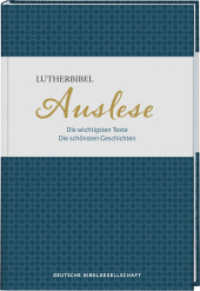Full Description
Now in its second edition, this volume provides an up to date, accessible, yet authoritative introduction to feedback on second language writing for upper undergraduate and postgraduate students, teachers and researchers in TESOL, applied linguistics, composition studies and English for academic purposes (EAP). Chapters written by leading experts emphasise the potential that feedback has for helping to create a supportive teaching environment, for conveying and modelling ideas about good writing, for developing the ways students talk about writing, and for mediating the relationship between students' wider cultural and social worlds and their growing familiarity with new literacy practices. In addition to updated chapters from the first edition, this edition includes new chapters which focus on new and developing areas of feedback research including student engagement and participation with feedback, the links between SLA and feedback research, automated computer feedback and the use by students of internet resources and social media as feedback resources.
Contents
Introduction. 1. Contexts and issues in feedback on L2 writing: setting the scene Ken Hyland and Fiona Hyland; Part I. Situating Feedback: Socio-cultural Dimensions: 2. Sociocultural theory: a framework for understanding socio-cognitive dimensions of peer feedback Olga S. Villamil and Maria C. M. de Guerrero; 3. Culture and peer feedback Guangwei Hu; 4. Appropriation, ownership, and agency: negotiating teacher feedback in academic settings Christine M. Tardy; Part II. Shaping Feedback: Delivery and Focus Dimensions: 5. The intersection between SLA and feedback research John Bitchener; 6. Does error feedback help L2 writers? Latest evidence on the efficacy of written corrective feedback Dana Ferris and Kendon Kerzer; 7. Electronic resources for feedback Marie Stevenson and Aik Phakiti; 8. Collaborative writing as peer feedback Neomy Storch; Part III. Negotiating Feedback: Interpersonal and Interactional Dimensions: 9. Interpersonal aspects of response: constructing and interpreting teacher written feedback Ken Hyland and Fiona Hyland; 10. Fostering formative online forums: feedback, dialogue and disciplinarity Ann Hewings and Caroline Coffin; 11. Supervisory feedback: building writing scaffolds with doctoral students Sue Starfield; 12. Reviewers' feedback on second language writers' submissions to academic journals Brian Paltridge; Part IV. Engaging with Feedback: Student Participation Dimensions: 13. Learner engagement with written feedback from a socio-cognitive perspective Ye Han and Fiona Hyland; 14. What messages do students take from teacher feedback? Ken Hyland; 15. Students initiating feedback: the potential of social media Soobin Yim and Mark Warschaeur; Index.








